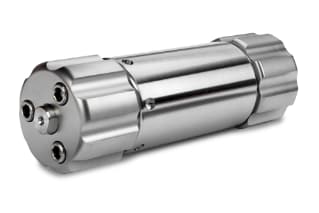
|
Chemistry |
C18 |
|
Separation Mode |
Reversed Phase |
|
Particle Substrate |
Hybrid |
|
pH Range Min |
1 pH |
|
pH Range Max |
12 pH |
|
Temperature Limits |
80 C (Low pH)/60 C (High pH) |
|
Maximum Pressure |
6000 psi (415 Bar) |
|
Endcapped |
Yes |
|
Silanol Activity |
Low |
|
Particle Shape |
Spherical |
|
Particle Size |
10 µm |
|
Endfitting Type |
Waters |
|
Pore Size |
130 Å |
|
Format |
OBD Prep Column |
|
Surface Area |
185 |
|
System |
HPLC Preparative |
|
Particle Technology |
BEH |
|
Technique |
LC/MS, LC |
|
USP Classification |
L1 |
|
Inner Diameter |
50 mm |
|
Length |
150 mm |
|
Carbon Load |
18 % |
|
UNSPSC |
41115709 |
|
Brand |
XBridge |
|
Product Type |
Preparative Columns |
|
Units per Package |
1 pk |

XBridge BEH C18 OBD Prep Column, 130Å, 10 µm, 50 mm X 150 mm, 1/pk
Preparative columns necessitate high levels of integrity and stability, demanding rapid, high-purity compound isolation. To answer these challenges, Waters’ Optimum Bed Density lab equipment is designed to support exceptional resistance to mechanical chromatographic bed failure and to deliver consistent column-to-column performance and reduced cost through an extended lifetime. XBridge BEH C18 OBD Prep Columns aim to maximize productivity when scaling up screening methods to preparative HPLC by screening with high resolution and speed and increasing laboratory throughput when directly scaling methods.
XBridge BEH C18 OBD Prep Columns can be used over an entire range of mobile phase pH, from 1 to 12, due to the workhorse of XBridge BEH C18 sorbent. The trifunctionally bonded C18 ligand provides a universal column for HPLC separations, with the widest usable pH range, superior low pH stability, and ultra-low column bleed. As part of the XBridge family of HPLC columns, these columns feature state-of-the-art bonding, end-capping, and particle synthesis. By combining the unique features of XBridge packing, OBD designs, and the patented BEH particle, XBridge BEH C18 OBD Prep Columns take performance to a new level that allows for direct scalability, maximum efficiency, and long column lifetimes.
XBridge BEH C18 OBD Prep Columns are packed to bed densities that closely match their equivalent analytical columns. This innovative procedure allows for preparative columns with excellent stability, reproducibility, and efficiency. Scientists can evaluate and benchmark their columns using the https://www.waters.com/nextgen/us/en/shop/standards--reagents/186006703-preparative-chromatography-mix-standard.html">Preparative Chromatography Mix Standard. All columns are manufactured and tested according to industry standards for XBridge columns.
How Do I Choose The Right OBD Preparative Column For My Separation?
Once your analytical separation has been optimized, a loading study on the analytical column should be performed to determine the capacity of a particular packing material. You can then determine how much mass you will need to purify or isolate. Simple equations can then be used to determine the required column size for purification. These help to determine the scale-up factor and flow rate needed for your analysis, helping to determine the proper column for your separation. Reasonable flow rates will be based on column diameter and limited by increasing backpressure with increasing column length and decreasing particle size.